Behind the Scenes of Last Meal at Cafe Mori
- Intro -
Hullo, and welcome to this behind the scenes article for Last Meal at Cafe Mori. I hope this article helps to both document the process of this project, as well as help give inspiration and guidance to people interested in making games.
- Memento Mori -
I wanted Last Meal at Cafe Mori to be a frank conversation with the player about death. About how it's something that should be thought about. Not necessarily in a depressingly morbid way, but in a sobering way that lets you think about your life, what you've done in the past, and what you'd like to do in the future. It's a "memento mori" from me to you.
I think that death and its inevitability is something many people don't like thinking about, even though it's a rather important subject. There's creators who have made stories about death (often in these stories, the protagonist is taken to an afterlife or underworld of some sort), and I appreciate them for talking about and exploring death and mortality in a light hearted way. The light hearted-ness is key because it makes it approachable for people. It becomes something you can look at without it feeling too overwhelming and unapproachable.
A memento mori ("remember death" in Latin) is something a person keeps to remind themselves of their own future demise. It can be a painting of a skull, a piece of jewellery shaped like a skull. Mine is a bracelet of skull-shaped beads I like to wear when I'm at work or outside.
As the various characters of the game tried to answer the question, "What is you most precious memory?" I hope that players took a moment to think about what their own answer would be.
- Making a Gift? -
Each of the characters have their own backstories on what their lives were like before they entered the cafe. They had conflict in their lives, and had to react to them in their own ways.
I wanted to give lessons that I though people like me needed, even if it was simple reassurance that, yes, I've felt that way too. You're not alone here.
- The Void -
Last Meal at Cafe Mori was definitely affected by 2020 and came from my experiences of it. I wanted to create a feeling of the world being in a downward state, ever-present in the background, but having a sense of being unable to do anything to stop it. The strange juxtaposition of being (relatively) safe and cosy indoors, but still knowing what's outside. In Last Meal at Cafe Mori, you cannot stop the Void. Not in any of its endings.
The Void is the pandemic. It's global warming. It's war. It's something global that affects everyone, yet is ignored by those who have the power to stop it. The Emperor has no clothes and we all can see it. The Void is something that creates conspiracy theorists who believe that the Earth is flat and that duck don't exist.
- Influences from Fiction and Other Places -
A list of various references and influences in the game:
Robyn and Death taking down the chairs from the tables, as cafe owners often do, is a reference to a Neil Gaiman quote, which ended up being displayed at the beginning of each playthrough of the game.
"When the first living thing existed, I was there waiting. When the last living thing dies, my job will be finished. I'll put the chairs on the tables, turn out the lights and lock the universe behind me when I leave." - Neil Gaiman, Dream Country
The cosmic bread ingredient in the minigame is a reference to a book that used a loaf of bread cut into slices to explain the multiverse theory, calling it a "cosmic loaf," which I found amusing and Douglas Adams-y.
The lemon being another ingredient is an homage to the DevTalk Discord server's mascot, Lemonchan, and her association with lemons.
The morel mushroom is a reference to Dear Devere, the last VN I made. One of the characters picks mushrooms in the story.
The jam jar of stars ingredient is a reference to the visual novel Starwatchers: The Search for the Cosmic Jam.
- Reincarnation and Buddhism -
In Last Meal at Cafe Mori, the universe the story takes place in rejects the concept of a heaven or hell, and instead focuses on more Buddhist theology.
Reincarnation and Existentialism:
Rebirth is a large aspect of Buddhism, placing existence as a circle. In Last Meal at Cafe Mori, the patrons are meant to be reborn after they leave the cafe. Robyn questions whether or not this will get to happen, because of the Universe ending, creating an abrupt end of the cycle. I wanted players to think about existentialism, and how they view their existence and their relationship to others and to the world.
Limbo and Bardo:
The cafe itself acts as a sort of limbo for characters who have died but haven't been reborn yet. In Buddhism, Bardo is sometimes described similarly to limbo: An in-between state where the recently deceased experience various phenomena before being reborn. The cafe in the game acts as this experience.
The Undead and the Animated:
Characters like Jack and the Ghost are in a state of being undead, while the Gargoyle is animated from stone. Buddhist folklore includes undead monsters, as well as animate bodies made of clay, stone, and other materials.
Nirvana:
In one of the endings, the player character, Robyn, references Nirvana by name. Nirvana is from Buddhism and (as Robyn put it) means "to blow out a candle," or to cease existing. Nirvana is the concept of the cycle of reincarnation coming to an end for a person and reaching a state of infinite peace.
- "It's a Show About Death" -
(Yes, the above lines is a Beetlejuice: The Musical quote.)
Going back to the subject of death, each of the different characters talk about not only how they died, but also how they lived.
Austin Kleon wrote in Show Your Work to "read obituaries," the reasoning being that many creators have had near-death experiences, citing them as part of their motivation to do what they enjoy for a living. Kleon wrote that artists who have not had such experiences, such as himself, can read obituaries to think about their own mortality.
There's a duality of thinking about mortality: By thinking about death, a person thinks about their life.
The Witch's story about her near death experience was based on a personal experience I won't get into, and she uses this childhood experience as a drive to pursue her ambitions and what she loves to do: Astrology.
- Robyn's Design -
Robyn's shirt has an image of an upside down tulip on it, flipping a symbol of springtime (and new life) into a symbol of death (and grim reapers).

Robyn's costume design also includes a silver chain (I gave her a design inspired by the punk and goth subcultures) that looks similar to the chain holding Mori's cloak. This was a nice happy accident, because I don't remember consciously thinking about that when I was designing Robyn and Mori.
- Spooky Easter Egg -
So far as I know (meaning, no one's messaged me about it), no player has discovered the Easter egg I hid in the game's files.

The file is a text document labelled "Dear_Hackers" and contained a short story about an unnamed character committing a murder (fitting enough to be in a Halloween themed October game, yet also different enough in tone to be a spooky surprise for players who discovered it). The story was originally a fanfic for the series Fargo, but with the names changed. The original fic with the names kept can be found here: AO3 Link
I plan on adding an additional Easter egg containing audio files of Mori quoting Discworld.
- Process -
After making devlogs for Dear Devere and finding that it made documenting my process on VN-making much more manageable, I decided to do the same thing for Last Meal at Cafe Mori.
The devlogs can be found here and give a good timeline on the different steps of production.
To go into more detail on the voice acting process, I sent test lines to the voice actors, along with descriptions of the characters and the game's setting.
I hadn't finished the sprite art at the time, so I used images from the internet as moodboards.
This was the moodboard/concept image of Jack I made by photobashing art of Stan from Monkey Island, Wash from Firefly, and some jack-o'lanterns.
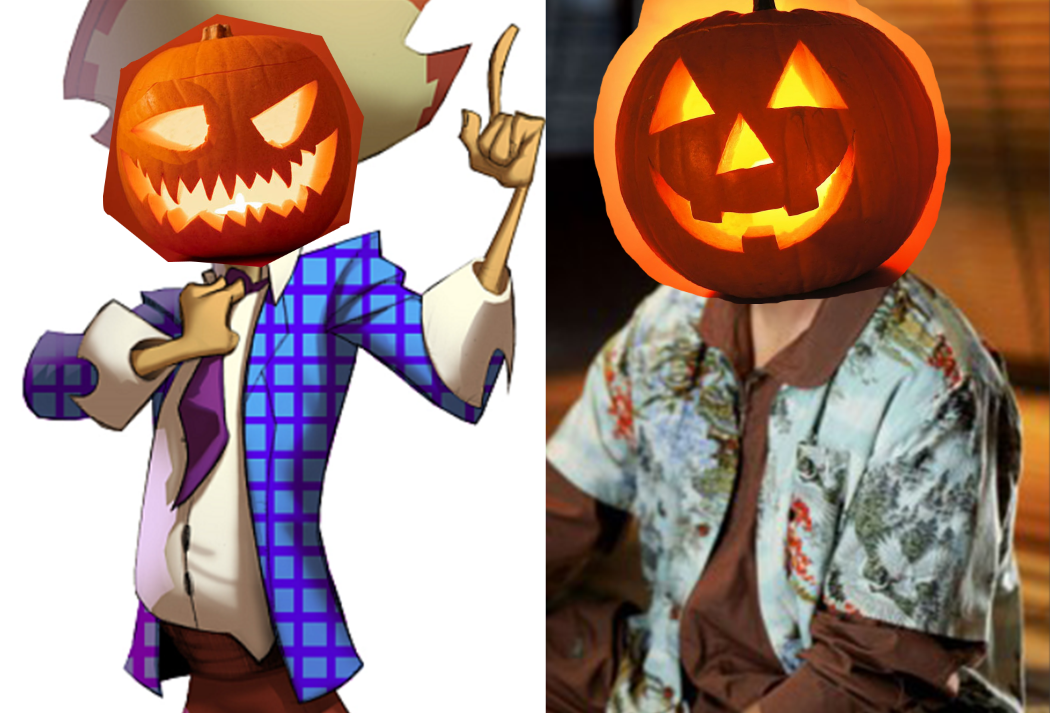
Here are some examples of the voice acting spreadsheets I gave to the voice actors.
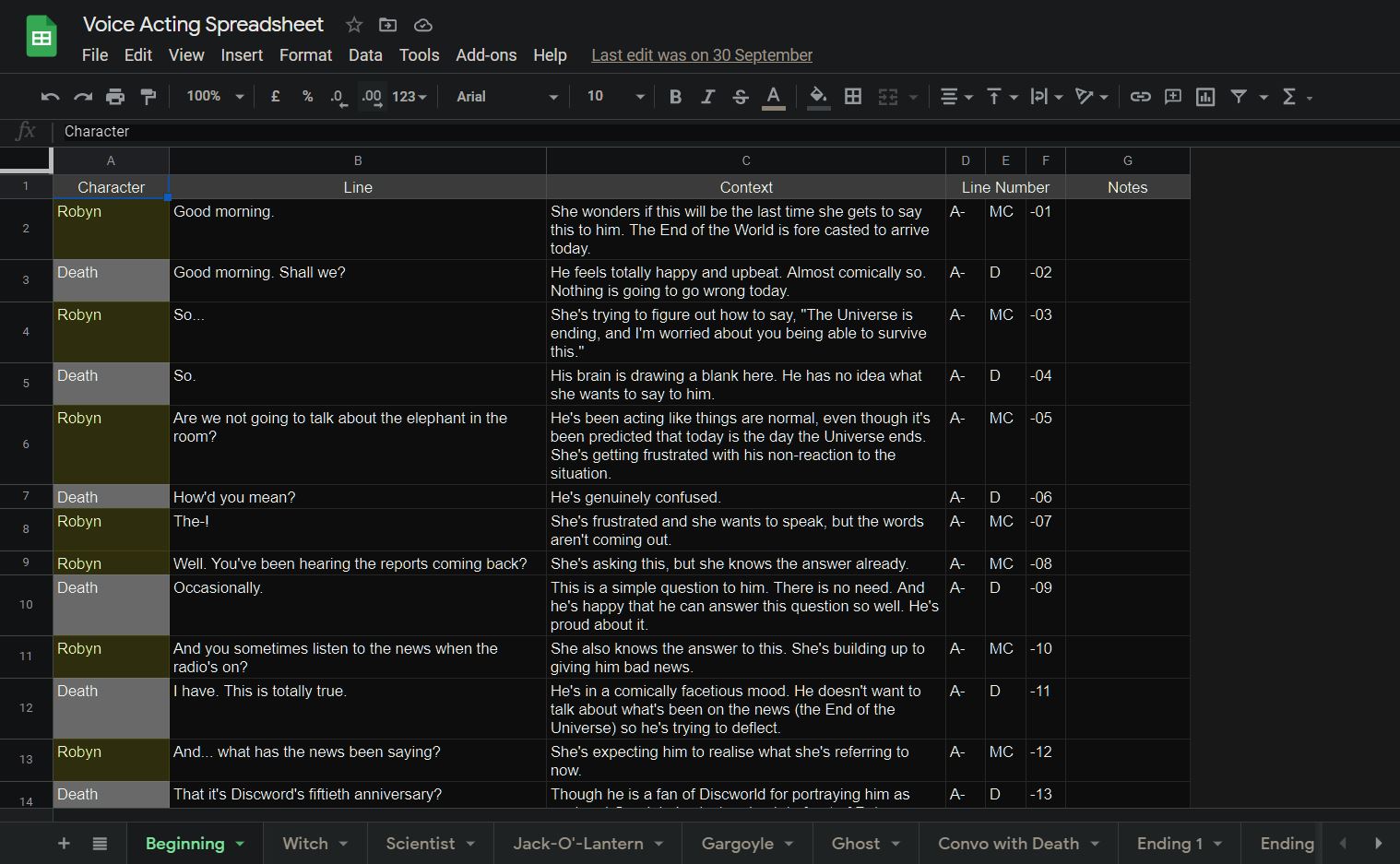
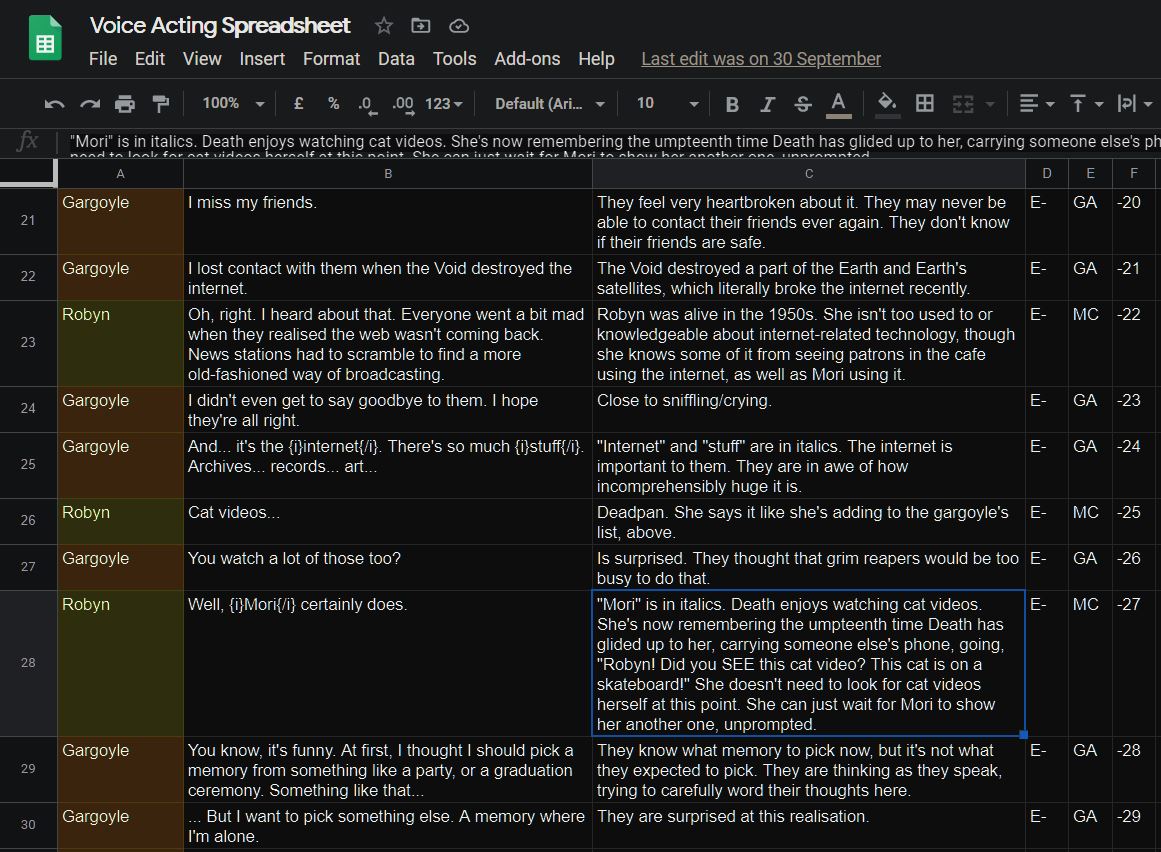
- Clip Studio Paint -
I decided that I wanted to use Spooktober as an opportunity to teach myself Clip Studio Paint.
This was because of two main reasons: I wanted to get ready and prepare to transition from using Photoshop to CSP in time for CSP's upcoming winter update (which has now, at the time of writing, come to pass). The update includes allowing people to import PS brushes into CSP, which was the main thing keeping me from using CSP.
The second reason I wanted to move away from PS was because of some particularly gross things Adobe has been doing during 2020, and it just feels more and more like Adobe's gonna metaphorically stab artists in the back.
Clip Studio Paint has some really cool features Photoshop doesn't have, like a pen stabiliser, which has been very helpful for me. It lets you livestream it within the window (something that PS doesn't like and that I used to have to do work-arounds for livestreaming) and now lets you record timelapse videos, similar to Procreate.
Some rough drafts of the artwork.

Drawing from my notebook when my laptop broke.
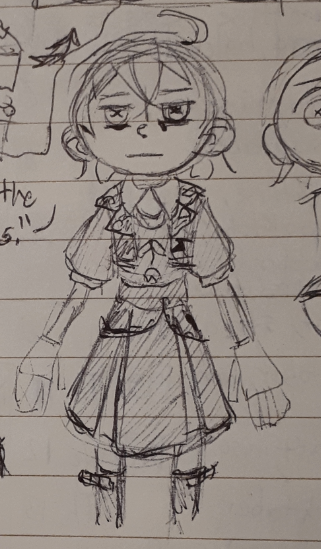
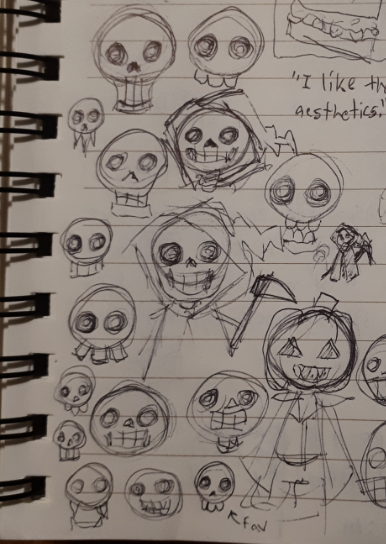
Trying to figure out Mori's skull.
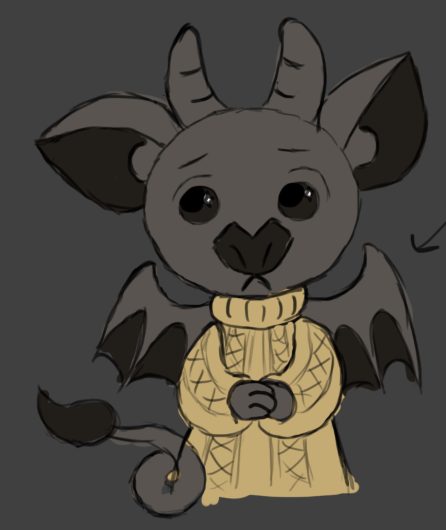
The Gargoyle was the first rough drawing I made.
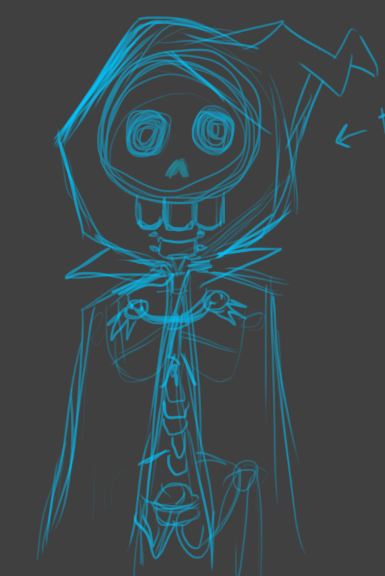
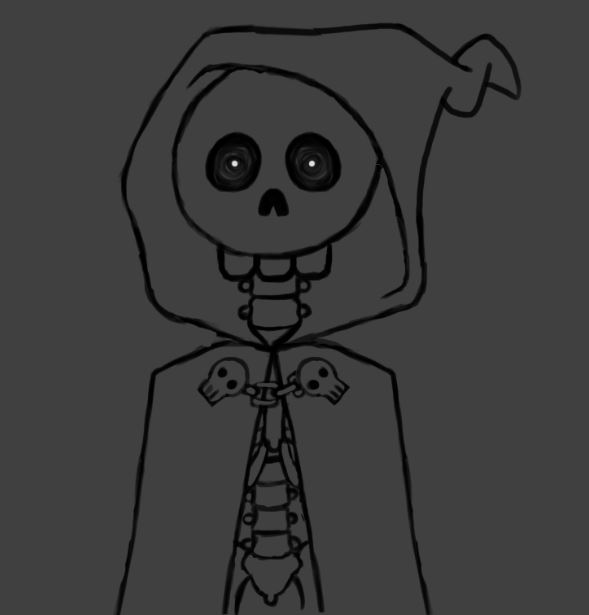
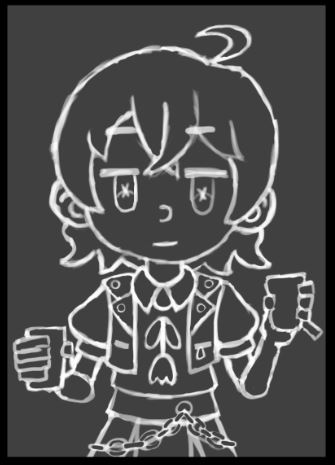
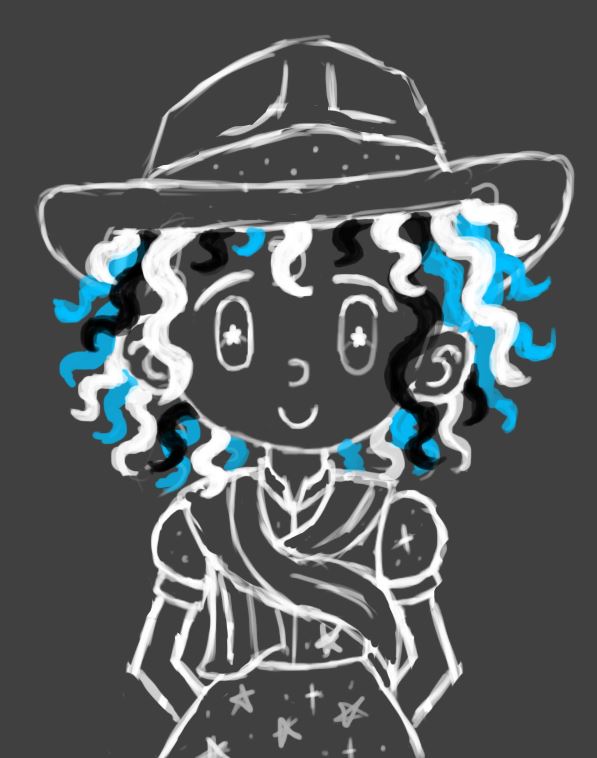
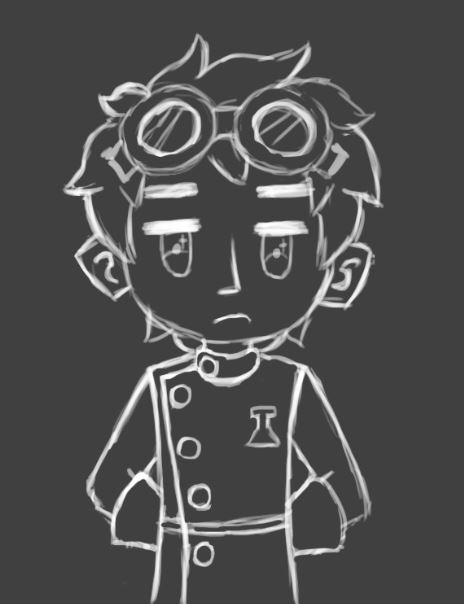

- Outro -
I hope that these articles help give people insight on the process of making Last Meal at Cafe Mori, and insight on making visual novels. I hope it encourages other creators to write their own for their projects.
Next, I'll post the game's postmortem article sometime in the future.
Turrah.
Get Last Meal at Cafe Mori
Last Meal at Cafe Mori
A visual novel about death, deserts, and introspection.
More posts
- Last Meal at Cafe Mori is now in French, Spanish, and German! (Version 1.2 Updat...Oct 01, 2023
- Sticker Pack Available!Mar 19, 2021
- Version 1.1 UpdateJan 04, 2021
- Interview with Katy and I Choose ParadiseDec 18, 2020
- PostmortemDec 14, 2020
- Devlog Week 5Oct 05, 2020
- Devlog - Week 4Sep 28, 2020
- Devlog Week 3Sep 21, 2020
- Devlog Week 2Sep 13, 2020
Leave a comment
Log in with itch.io to leave a comment.